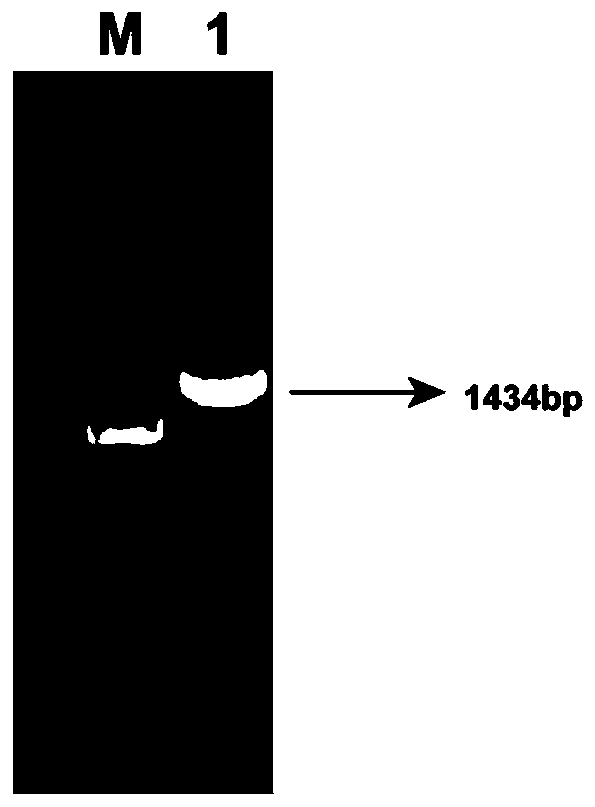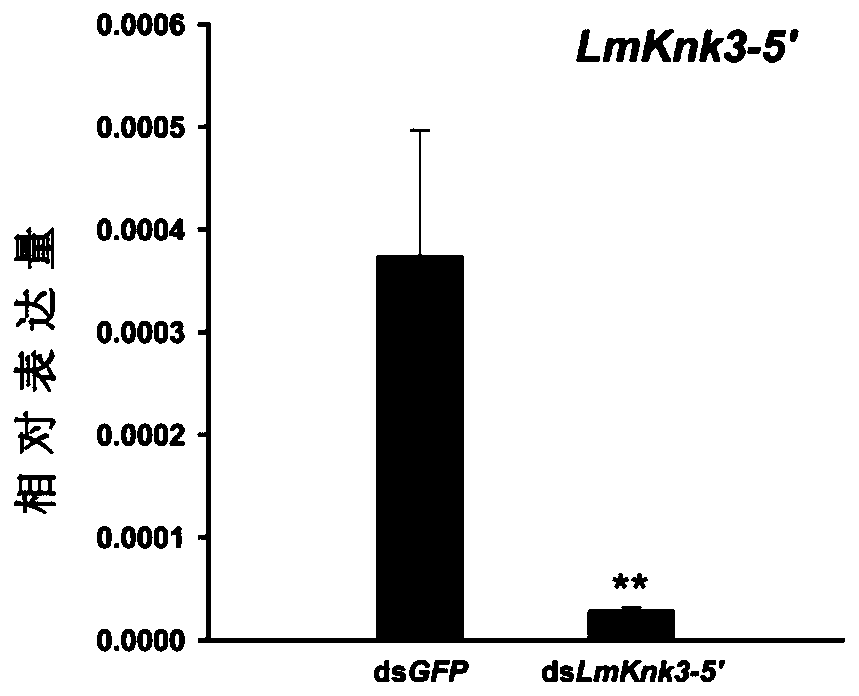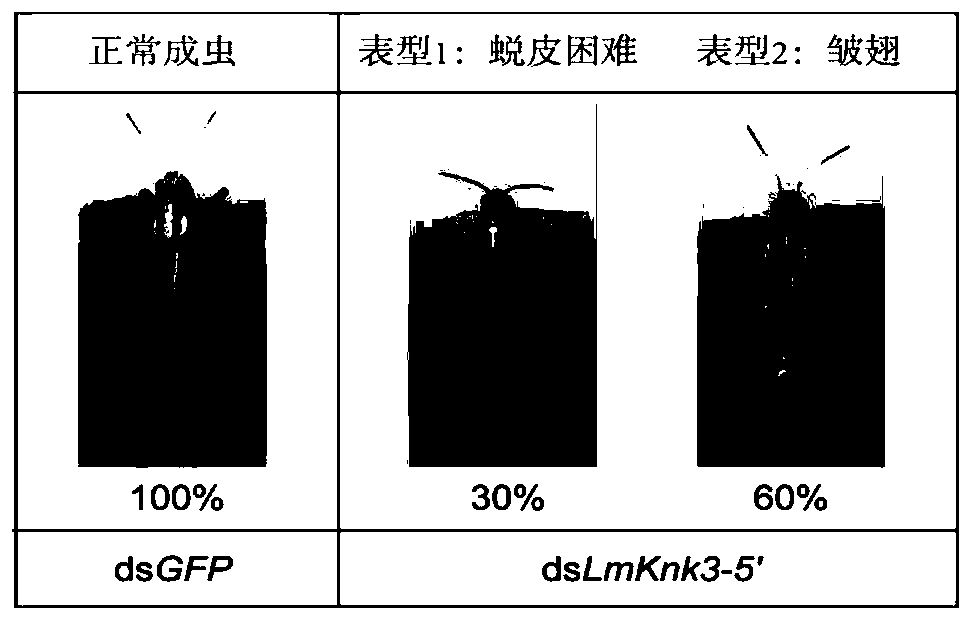Application of migratory locust Knickkopf 3-5' gene dsRNA in pest control
A technology of migratory locusts and genes, applied in the direction of DNA/RNA fragments, applications, genetic engineering, etc., can solve the problems of slow effect, damage to the agricultural ecological environment, and long killing time, and achieve a high lethal effect
- Summary
- Abstract
- Description
- Claims
- Application Information
AI Technical Summary
Problems solved by technology
Method used
Image
Examples
Embodiment 1
[0014] Example 1: Acquisition of the full-length cDNA of the migratory locust Knickkopf 3-5' gene
[0015] 1. Search from the migratory locust transcriptome database, and then use the NCBI Blastx online software to analyze, and determine to obtain a migratory locust Knickkopf 3-5' gene sequence.
[0016] 2. The upstream primer ATGGAGGCCCGCACGTGCA (SEQ ID NO: 2) and the downstream primer CTACTTCTGCTGCTGGTAGT (SEQ ID NO: 3) were respectively designed using primer premier 5.0 software. The designed primers were sent to Sangon Bioengineering (Shanghai) Co., Ltd. for synthesis.
[0017] 3. Select the 5th instar nymphs of migratory locusts with uniform size and good growth condition, peel off their epidermis quickly, and store them in liquid nitrogen, then extract RNA according to the method of TaKaRa Trizol kit, and use M-MLV reverse transcriptase to extract RNA. Reverse transcribed into the first-strand cDNA as the template required for the amplification of the full-length sequen...
Embodiment 2
[0019] Embodiment 2: Obtaining of dsRNA of migratory locust Knickkopf 3-5' gene fragment
[0020] 1. Based on the nucleotide sequence SEQ ID NO: 1 of the migratory locust Knickkopf 3-5' gene, use primerpremier5.0 software to design a pair of upstream and downstream primers required for the synthesis of dsRNA, taatacgactcactatagggCGTCTCGCGGTTCCTTCCGGTTC (SEQ ID NO: 4) and taatacgactcactatagggTACTTCTGCTGCTGGTAGTTTGC (SEQ ID NO :5), the part in italics is the T7 promoter. The primers were sent to Shanghai Sangon Bioengineering Co., Ltd. for synthesis.
[0021] 2. Using the above primers and the full-length plasmid of migratory locust Knickkopf 3-5' as raw materials, PCR amplification was performed to obtain a 383bp fragment. Its nucleotide sequence is the sequence shown in SEQ ID NO: 6, and both ends contain T7 promoters. After the product was purified by Gel Extraction Kit (Omega), it was quantified using NaNoDrop 2000 (Thermo scientific) and used as a template for dsRNA synth...
Embodiment 3
[0023] Embodiment 3: The dsRNA synthesized by the migratory locust Knickkopf 3-5' gene fragment is lethal to migratory locusts
[0024] 1. Injection of dsRNA
[0025]100 well-developed, uniform-sized migratory locust fifth-instar first-day nymphs were selected for dsRNA injection. The worms injected with dsGFP were set as the control group, and the worms injected with dsLmKnk3-5' were set up as the treatment group. The control group and the treatment group were injected with 50 worms, half male and half male. 20 μg of dsRNA was injected into the locust body cavity along the second abdominal segment of the migratory locust abdomen with a micro-injector. After the injection, the two groups of nymphs were respectively placed in sarongs of 30cm × 30cm, given the same conditions (light: dark time=14h:10h, temperature 30±2°C, humidity 60%) to raise, and a sufficient amount was supplied every day. fresh wheatgrass and wheat bran.
[0026] 2. Detection of mRNA expression of migrato...
PUM
 Login to View More
Login to View More Abstract
Description
Claims
Application Information
 Login to View More
Login to View More - R&D
- Intellectual Property
- Life Sciences
- Materials
- Tech Scout
- Unparalleled Data Quality
- Higher Quality Content
- 60% Fewer Hallucinations
Browse by: Latest US Patents, China's latest patents, Technical Efficacy Thesaurus, Application Domain, Technology Topic, Popular Technical Reports.
© 2025 PatSnap. All rights reserved.Legal|Privacy policy|Modern Slavery Act Transparency Statement|Sitemap|About US| Contact US: help@patsnap.com



